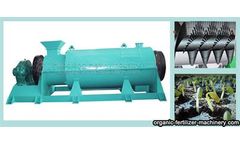Seedling Root Articles & Analysis
7 articles found
The root system of plug seedlings and the root clusters formed by the matrix network is very firm. Regardless of manual or mechanical transplantation, root clusters are not easy to spread and be injured. After transplanting, the embolized seedlings can grow quickly without delaying the growth of traditional ...
The organic fertilizer granulator adopts the microbial fermentation technology to make the manure of livestock and poultry, urban garbage, etc. into deodorized and sterile organic fertilizer with high fertilizer efficiency and without burning roots and seedlings, which is used in the grain field, fruits, vegetables and flowers, and is suitable for the technical ...
Previous studies found a significant effect of BPA on levels of mineral nutrients in plant roots, but the underlying mechanism remains unknown. To determine how BPA influences root mineral nutrients, the effects of BPA (1.5, 3.0, 6.0, 12.0, 24.0, 48.0 and 96.0 mg L−1) on activities of critical respiratory enzymes (hexokinase, phosphofructokinase, pyruvate kinase, ...
Here, the effects of BPA on the antioxidant system [superoxide dismutase (SOD), peroxidase (POD), catalase (CAT), ascorbic acid (AsA), proline, reduced glutathione (GSH)], reactive oxygen species [ROS, hydrogen peroxide (H2O2), superoxide anion (O2—)] accumulation and membrane lipid peroxidation [malondialdehyde (MDA), cell membrane permeability] in soybean seedling ...
In the present work, the effects of BPA on the biomass (fresh and dry weight), absorptive function (activity and absorptive area), and mineral element levels in soybean (Glycine max L.) seedling roots treated with 1.5 mg L‐1, 3.0 mg L‐1, 6.0 mg L‐1, 12.0 mg L‐1, 24.0 mg L‐1, 48.0 mg L‐1, and 96.0 mg L‐1 BPA were investigated. Treatment with 1.5 mg L‐1 BPA ...
Here, the effects of combined BPA and Cd pollution on soybean seedling roots were evaluated in pot experiments. The combined treatment with BPA and Cd at the low concentrations (1.5 mg/kg BPA and 0.2 mg/kg Cd) improved soybean seedling root growth. However, the other combined BPA and Cd treatments, including the combined ...
The goal of this study was to examine the effects of wind and wind blown sand abrasion damage on cotton (Gossypium hirsutum L.) seedling biomass partitioning to leaves, stems, and roots. Seedlings of three cotton cultivars were exposed to no wind (untreated controls) or sand abrasive flux densities of 0, 0.1, 0.25, 0.35, and 0.5 g cm–1 width s–1 ...




